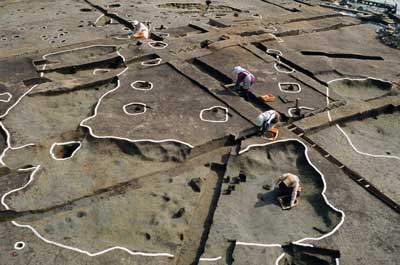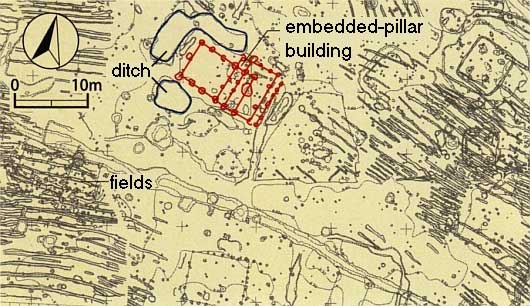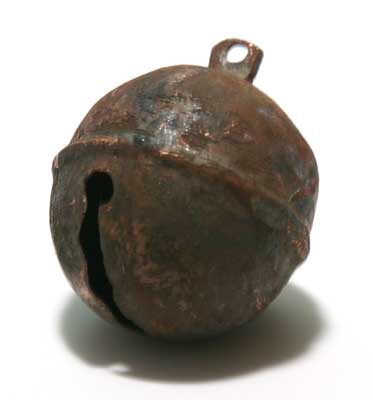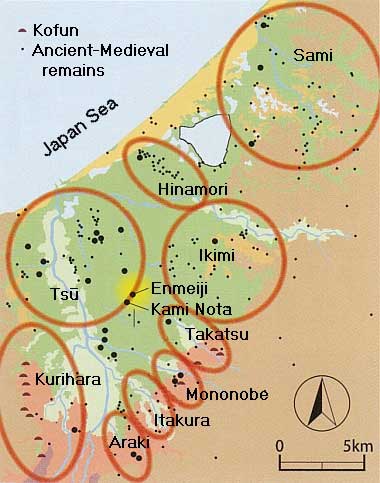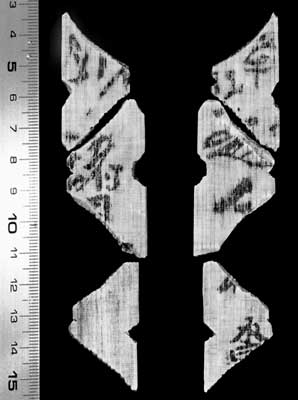Enmeiji: A contract mokkan (wooden document) of the early seventh century administrative system is recovered. A governmental local branch office? Conditions of development in the ancient period come to light.
Enmeiji Site, Jōetsu City, Niigata Prefecture
A governmental branch office in the local community
Enmeiji is a settlement site from the Asuka and Nara periods, located on alluvial soils on the west bank of the Iida river, near the center of the Takada plain in the southwestern part of Niigata prefecture. The Takada plain was part of Kubiki district, where the provincial headquarters of ancient Echigo province was located, and is thought to be an area developed from ancient times.
Among the features discovered in the 2006 and 2007 investigations, for the Nara period there were 6 embedded pillar buildings, 8 wells, pits, dry fields, and rice paddy. Among the embedded pillar buildings were some for which the ground was prepared with fill prior to construction. At a point approximately 50 m distant from the buildings, a pit from which wooden ritual paraphernalia were recovered together was discovered, and from the conditions of discovery it was seen that ritual implements which had been used only once, at a government office or somewhere, had subsequently been discarded.
Among the artifacts, along with pottery of the Nara period there were wooden ritual paraphernalia, metal fittings of belts worn by officials, bronze bells, mokkan (wooden documents), etc., and it is understood from these artifacts and features that Enmeiji of the Nara period was a site closely related to a government office.
The oldest contract mokkan is recovered
The recovery of a mokkan relating to the leasing of paddy land drew considerable attention. It is inscribed with a contract whereby 3 tan (1 tan = approx. 1,190 sq m) of paddy named Nara and 6 tan (?) of paddy named Nakaie in Nota village, owned by Mononobe Torimaru, were loaned by Mononobe Hiro to Saka no Kimi Ōshima of Ikimi township for the annual rent of 2 koku and 1 to (10 to = 1 koku = approx. 180 l, or 5.1 bushels) of rice; a district official supervising paddy agriculture signed the back of the document, giving public recognition to the contract.
Wooden documents inscribed in this manner with contracts for the sale or lease of land are called "contract mokkan," and the current item, inscribed with a date from the year Tenpyō 7 (735), is the oldest surviving example of its kind.
From the place name "Mononobe township (gō), [undecipherable] neighborhood (ri)," it is clear that this mokkan dates from the period spanning 715 to around 740, when the gōri administrative structure was in place. As the village name of Nota is inscribed, the possibility moreover emerges that the section names Shimo Nota and Kami Nota, seen in the immediate vicinity of the site, date back to the Nara period.
Local elite under the ritsuryō system as revealed by mokkan
This mokkan indicates that development of the site's environs was done at the hands of the Mononobe, and from the conditions at the site itself, this development is thought to have begun in the Asuka period. Asuka period buildings have yielded gold earrings and other items showing a relatively powerful family lived at the settlement, and it is supposed that in the Nara period there were figures with ties to governmental offices.
Changes at the Enmeiji site from the Asuka to the Nara periods reflect the process by which, as the ritsuryō system was enacted, the local elite stratum and their settlements assumed the position of the furthest extent of regional government. (Yamazaki Tadayoshi)
 Contract mokkan
Contract mokkanLength: 48.6 cm; width: 4.9 cm; thickness: 0.6 cm.
This is the oldest surviving contract mokkan. It is inscribed to the effect that the paddy supervisor, whose name may have been read as Kanda no Kimi Maro, recognized on the 21st day, 3rd month of 735, that Mononobe Torimaru, a member of the family of household head Mononobe Tarimaru of [undecipherable] neighborhood, Mononobe township, loans 3 tan of Nara paddy and 6 tan (?) of Nakaie paddy which he owns in Nota village to a person of Ikimi township, Saka no Kimi Ōshima, for the annual rent of 2 koku and 1 to of rice, the executor (lender) of the contract being Mononobe Hiro, also a member of Tarimaru's family.
Let's think about the background of this wooden document. In the initial implementation of the ritsuryō system, which took all land and citizens as belonging to the state, there were privately owned lands that had been previously developed in the Asuka period, and as the vertically integrated administrative structure of province/district/township/neighborhood was implemented, there were cases of land leasing arrangements that transcended local administrative units. It can be seen that the district official who supervised paddy agriculture was involved in such leasing contracts. Figures visible in the mokkan are: Mononobe Tarimaru, a member of the powerful Mononobe family of the township bearing their name, who began development in the Asuka period; Saka no kimi Ōshima of Ikimi township, who leased the paddy in the 730s in an attempt to increase his harvests; the man whose name was perhaps read Kanda no Kimi Maro, thought to have been a locally prominent figure who was appointed to the post of district supervisor of paddy agriculture.
In addition there were 20 other mokkan recovered, including those related to the transport of rice, the loan of seed rice, and an item dated to the eighth month of 736. As provincial headquarters is thought to have been involved in the loan of seed rice, in this regard as well a close link is surmised between the Enmeiji site and a local government office. (Yamazaki Tadayoshi)
